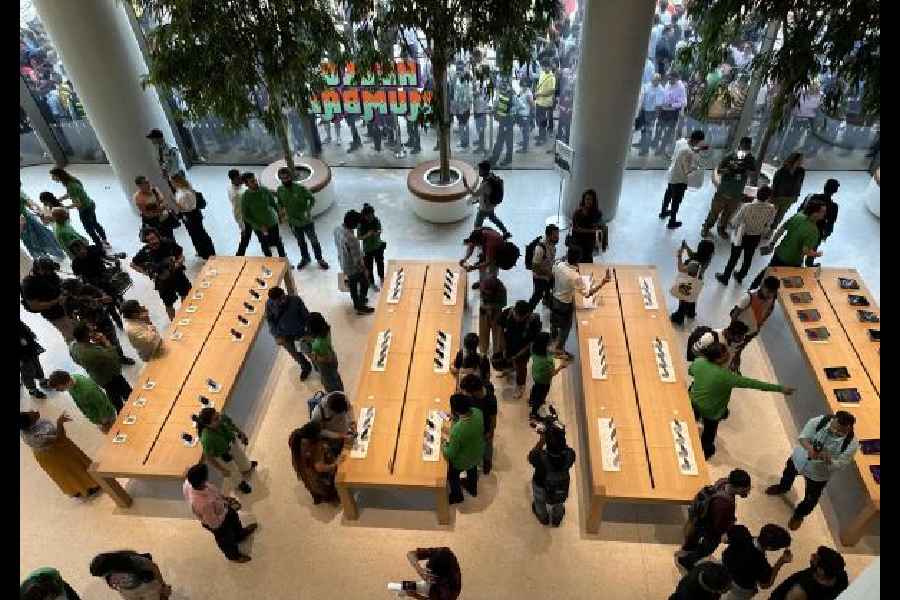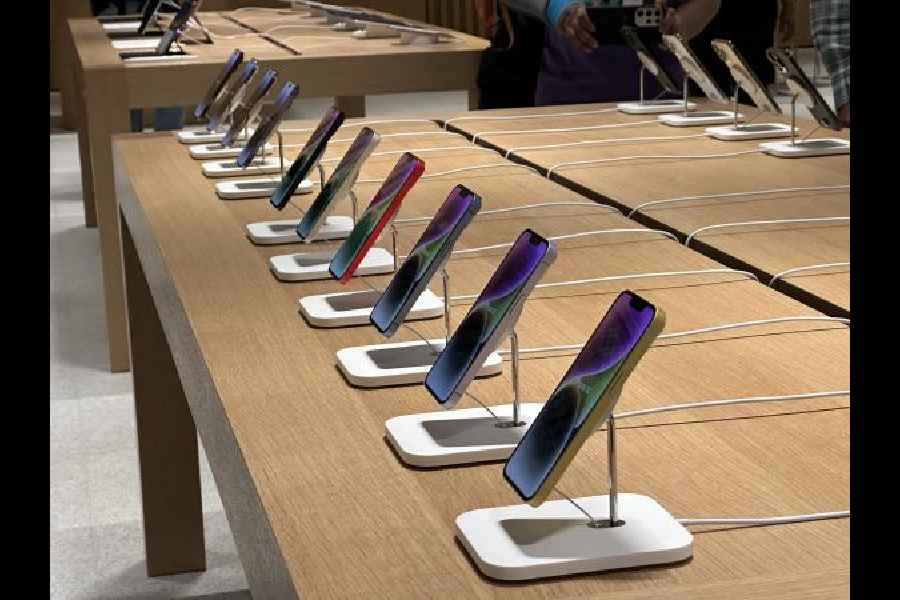Apple’s recent earnings report had something interesting to suggest — consumers may cut down on certain costs (like maybe buying fewer iPhones unless necessary) but nobody minds spending on essential services. Earlier this month, the world’s most valuable tech company reported that its revenue fell one per cent — to $81.8b — during the three months that ended in June but profit increased two per cent, to $19.88 billion.

Apple BKC in Mumbai on its first day of business
A case of two worlds is unfolding at Apple. The iPhone, which comprises half of Apple’s overall revenue even though it was introduced in 2007, continues to be a strong contender in the tech landscape but, at the same time, Apple is turning out to be a strong contender in the services space, so much so that it now has more than a billion paid subscriptions across all of its services, including Apple Music, iCloud, Apple News, Apple TV+ and more. All these figures are unfolding before September, which is a marquee month for Apple when it launches its new series of shiny iPhones, the next series being iPhone 15.
Looking at revenue from services, it represented more than a quarter of Apple’s total sales last quarter vis-a-vis services revenue represented just 10 per cent of quarterly revenues eight years prior, in 2015. The growth has been phenomenal. The company doesn’t always report its total number of subscribers, but it did one year ago — 860 million subscriptions, which means there has been an addition of 140 million in a single year. This for a company that was once known primarily for its hardware.
A plethora of options
A lot of things are at play here. First, consider iCloud where users store pictures and videos from vacations, birthday parties, special office moments, besides important documents and whatnot. A few years ago, I would have been happy to suggest an iCloud+ account (iCloud+ is Apple’s premium cloud subscription) with 50 GB storage. Over the years, iPhones have been faithful friends and never missed a photo or corrupted a video file. It’s the most reliable camera you can have on you at the moment. As storage space got filled up, many moved to 200GB storage at a higher price. I am guilty of 2TB storage, which is the highest tier. Once you start stuffing iCloud+ accounts, you really don’t want to switch over to any other service. It’s seamless, safe and has the right pricing.
Second, Apple has made some clever deals when it comes to live sports. This is a company that, at one point, didn’t even consider getting into live sports. In fact, it had to think twice before getting into streaming at all with Apple TV+. While most rival streaming services are bleeding and going in for ad-centric tiers to bring down pricing while attracting new viewers, Apple TV+ continues to deliver top-notch original shows.
In November 2019 arrived Apple TV+, which challenged Netflix and Amazon by offering original shows and movies. Next came exclusive sports rights. In March 2022, Apple reportedly committed $85m annually over seven years to stream Major League Baseball (MLB). The agreement gave the company exclusive rights to broadcast two Friday Night Baseball games in the US and eight other countries, including key Apple markets such as Japan, Canada, Australia, the UK and Germany. This year, Apple expanded its MLB coverage across 60 countries or territories.

A visitor to Apple BKC in Mumbai
In 2022, Major League Soccer’s (MLS) global and local rights were due for renewal. In June last year, MLS announced a broadcast deal with Apple that came for a reported minimum of $2.5b commitment over the next decade. And then came the golden moment: MLS team Inter Miami enticed Lionel Messi to the US. Now you can catch a glimpse of Messi on Apple TV+ through the MLS Season Pass. “Soccer legend Lionel Messi made his debut with Major League Soccer last month, and fans all over the world tuned in with MLS Season Pass,” Apple CEO Tim Cook said recently.
Further, last year NFL was looking for someone to pay up to $50 million per year to attach its name to the famous Super Bowl halftime show. Apple Music stepped in. Sports Business Journal reports it’s a five-year deal worth roughly $50 million per year.
Apple executives have a positive outlook for the services business for the current quarter. Recently, CFO Luca Maestri said Apple will be able to convert free users in the ecosystem to paid users through its larger portfolio of content. “I would say the biggest opportunity is that we know that there’s a lot of customers that we have that are very familiar with our ecosystem. They are engaged in the ecosystem. But still today, they’re using only the portion of the ecosystem that is free. And so we think that by offering better content and more content over time, we’re going to be able to attract more of them as paid customers,” he said on the earnings call.
What does it mean for the hardware business?
The beauty of Apple’s strategy is that it doesn’t need to depend on iPhone sales alone. They simply need to ensure that people use iPhones. I use Apple TV+, Apple Arcade, iCloud+, make all my app payments through the App Store, and so on. People will eventually upgrade, whether in four years or in September when the new iPhones arrive. It’s unnecessary to ask the question about who needs a new iPhone every year. The reality is that most users do not upgrade every year but there will always be a sizeable number of people getting new iPhones every year and the base is extremely big. Services have made Apple less dependent on waiting for us to buy the next iPhone, because they now get constant revenue from users.

iPhones lined up at Apple Saket in Delhi
What can make people buy the next iPhone? Plenty. One expects four new iPhones — iPhone 15, iPhone 15 Max, iPhone 15 Pro, and iPhone 15 Pro Max. Rumours point to the company making the switch from Lightning to USB-C while the Dynamic Island, which, at the moment, is exclusive to the Pro models from 2022, might find a home in the non-Pro iPhone 15 and iPhone 15 Max. The new Pro models are expected to come with titanium frames, instead of stainless steel, making them stronger and lighter, according to Mark Gurman. Also, the mute switch could be swapped out for a customisable button. Plus, there will be new periscope camera technology and A17 chips on the Pro models.
The upgraded three-nanometer A17 chip (unconfirmed) will be exclusive to the iPhone 15 Pro and iPhone 15 Pro Max while the iPhone 15 models are expected to use A16 chip that’s in the iPhone 14 Pro and Pro Max. Apple is also expected to introduce a new Ultrawide Band chip for nearby interactions, with the UWB chip integrating with the Vision Pro headset that Apple will introduce in early 2024.
What’s the takeaway? If you are using an iPhone and one of its services, expect things to remain flawless. You won’t have any problem watching Messi play for Inter Milan. He has scored seven goals and contributed three assists in four games, all of which Miami won. In pre-Messi days, Miami was on an 11-game winless streak.










